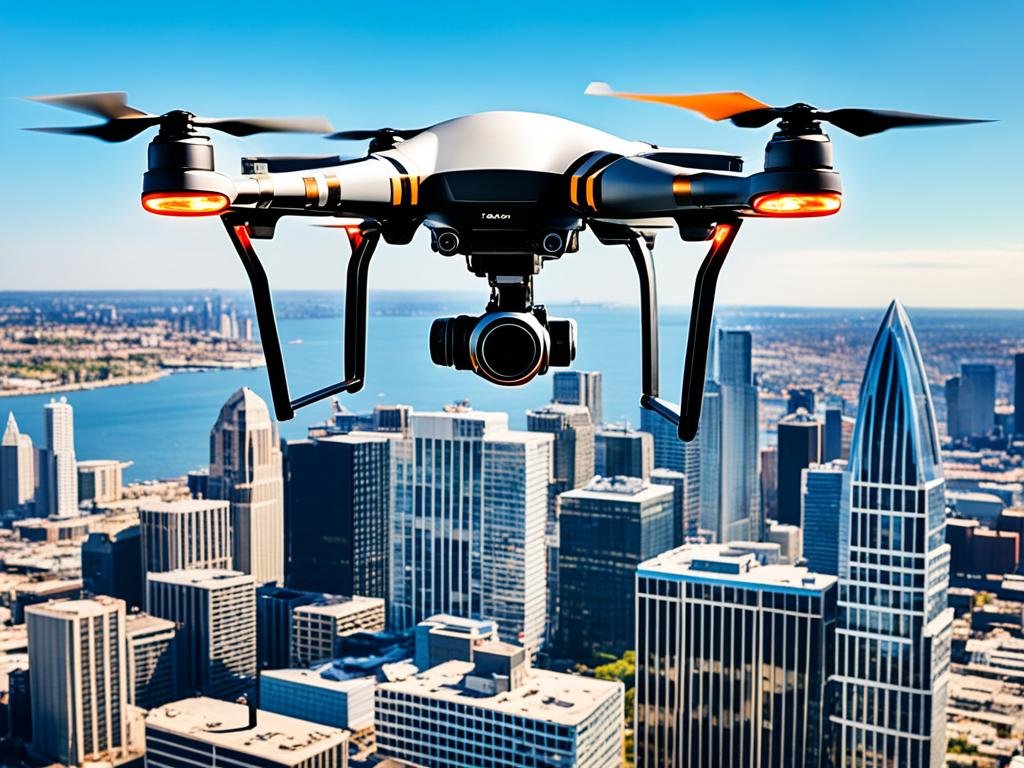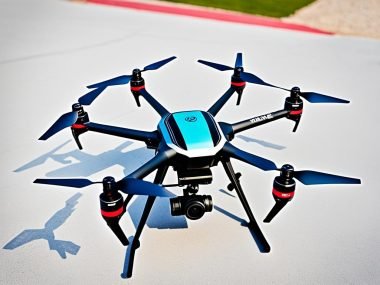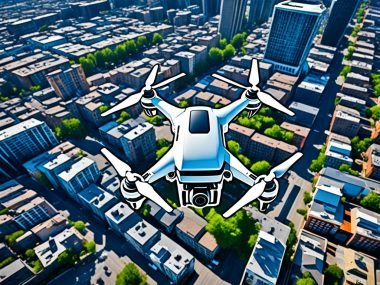In this age of rapid innovation, the drone industry has seen its revenues reach about $100 billion. This isn’t just imagination at work; it shows the huge potential for earnings in the drone business. Thinking of starting a drone business brings to mind successful companies like DJI. They fuse customer demand with commercial use, from taking photos from the sky to using drones for checking structures.
Is it possible to make a good profit from drones? With the right skills and knowing the rules, the answer is yes. Drone businesses can really make money.
Running a successful drone business is not just about starting up. It’s also about knowing what the market wants and using that knowledge well. As drone tech gets better, it’s clear they’re more than just for getting a high view. Drones are opening doors to new advances in surveying, mapping, and checking important structures safely.
Key Takeaways:
- The global drone market’s revenue illustrates the vast potential for starting a drone business.
- Success in the drone industry hinges not only on technology but also on understanding market demands and regulations.
- With the right skills and business strategies, drone business profitability is within reach.
- Leading companies like DJI showcase the profitability achievable with consumer and commercial drones.
- Offering unique drone services tailored to customer needs is crucial for gaining a competitive advantage.
Overview of the Drone Industry’s Growth and Potential
The drone industry profits have soared with commercial applications changing the market. As an expert, I’ve seen how drones open new business chances. Many wonder, “How profitable are drone businesses?” as they enter this sector.
The drone market is growing steadily. Market predictions look good for drone industry profits. Yet, we must be cautious in estimating the market size. The competition is intense, pushing companies to innovate for success.
In my analysis, I’ve found a balance is crucial in the drone world. To stand out, firms must have unique services and a strong brand. This raises the question: How profitable are drone businesses amid stiff competition?
A tempered yet enthusiastic narrative seems to characterize the drone industry’s trajectory—buoyancy in sales and applications, juxtaposed against the robust, competitive environment.
Profitability in drones is complex. Success links to innovation, adaptation, and meeting market needs. The drone business is full of potential, but it demands strategic flexibility for real profits.
Exploring the Revenue Potential of Drone Businesses
The drone industry is taking off, opening doors for various services. These businesses can make good money by offering services like amazing aerial photography and detailed aerial surveying. Drones have become key tools for many sectors.
What Services Do Drone Businesses Offer?
Drone businesses do more than you might think. They’re big in aerial photography and videography, especially for real estate and ads. But they also do crucial work like surveying, mapping, and inspecting structures. This work gives valuable data to many industries.
Plus, drones can carry advanced thermal sensors for environmental studies and precision farming. This boosts the income drones can make. These services provide not just data but insights that improve efficiency and productivity.
Pricing Strategy for Diverse Drone Services
Setting the right prices is key for a drone business’s success. Pricing has to reflect the service’s complexity, equipment used, and the skill required. Simple aerial photos might be cheaper, while aerial mapping or surveying costs more due to their higher complexity.
A flexible pricing model lets drone businesses serve everyone. From freelancers needing a few aerial shots to big companies wanting detailed surveys. Being able to adjust prices is vital for success in this field.
Understanding Your Customer Base and Their Spending Habits
Knowing your customers is crucial for making more money in drones. Real estate agents want great aerial shots for listings, and farmers might use drones to check their fields. Each group has its own budget.
Finding success in drones also means understanding what different customers need, both how often and how much. Some areas, like agriculture or construction, might be more profitable because drones can save them a lot of money. These areas might have bigger budgets for drone services.
The drone business has a lot of room to grow. Success comes from offering great services, smart pricing, and knowing what customers want. By focusing on these areas, drone businesses can aim for strong profits and stand out in a crowded market.
Key Success Factors for a Profitable Drone Business
Starting a drone business is both complex and rewarding. It combines technical skills with strong business sense. Success comes from blending these aspects well. Each flight should aim for profit, not just altitude.

Technical Skills and Business Acumen
To run a drone business, you need to know a lot. Understanding FAA rules is key. This knowledge keeps your business safe and legal. It’s more than flying; it’s steering your business within the law.
Uniqueness and Competitive Edge
Being different is key in the drone market. Your unique approach should match your marketing. Offering innovative drone services attracts customers. My focus is on being unique and offering top-notch service. This makes my brand stand out.
Expanding Services and Continuing Education
The drone field is always changing. Keeping up with new drone services is crucial. I learn constantly to stay ahead. This lets me offer the latest and greatest to clients. My goal is to lead in innovation, not just follow.
Operational Costs and Challenges in Running a Drone Business
Exploring the drone world shows a mix of costs and challenges that affect drone business profitability. Keeping a drone business going needs a balance of money coming in and going out. Major expenses include high-tech drones and advanced software, which need a big initial payment.
Ongoing maintenance and updates are crucial to stay ahead. Drones are fragile and their upkeep costs can add up. Also, insurance costs for flying drones are necessary but increase the expenses.
Following commercial drone regulations also takes a bite out of profits. Laws about drones keep changing. Staying updated is key to avoiding fines and keeping drones flying. Not following the rules is risky and costly.
The drone market is getting crowded as more pilots get FAA licenses. To stay profitable, finding a unique market space and using smart financial tactics are essential.
To show how complex this is, I made a detailed table. It compares key costs to potential savings or income they might bring.
| Expense Category | Typical Cost | Potential Savings/Revenue | Regulatory Considerations |
|---|---|---|---|
| High-Performance Drones | $1,000 – $4,000 | Increased service range and quality | Aircraft registration with FAA |
| Ongoing Maintenance | $100 – $500/year | Prevention of costly repairs | Compliance with maintenance protocols |
| Insurance | $500 – $2,000/year | Liability protection | Insurance as per local regulations |
| Training & Certification | $300 – $500 | Access to commercial opportunities | FAA Part 107 or equivalent |
| Legal & Compliance Advisory | $1,000 – $5,000/year | Minimization of legal risks | Adherence to changing regulations |
Managing a drone business’s money involves more than just flying skills. It means carefully steering through the financial aspects as well.
Real-world Insights on Drone Business Profitability
The drone industry is fast-changing, filled with both wins and hurdles. As I explore real examples, it’s clear that making money involves more than a great product. Understanding market analysis, UAV trends, and beating market competition is essential.
Case Studies: Successes and Setbacks in the Drone Industry
Drone businesses come with their ups and downs. From pioneering commercial UAV pilots to small companies fighting regulations, every story shares unique insights. DJI’s rise as a market leader shows the power of smart positioning and innovation. Yet, many companies struggle with high costs and tough laws, showing the thin line between success and failure.
Current Market Trends and Their Impact on Profitability
The future of drones is shaped by current tech trends, affecting business success. The fight in a crowded drone market pushes companies to find their special spot. Be it in inspections, farming, or city planning, staying agile and tuned to market demands is key to doing better.
| Trend | Impact on Industry | Response Strategy |
|---|---|---|
| Advancements in UAV Technology | Falling hardware costs; Increased competition | Focus on specialized services and software solutions |
| Regulatory Changes | Heightened compliance costs; Restricted operations | Stay informed; Advocate for reasonable drone policymaking |
| Market Oversaturation | Price undercutting; Profit margin pressures | Develop a strong brand identity; Offer value-added services |
| Consumer Demand Shifts | Changing service requirements; Opportunity for innovation | Conduct regular market analysis; Engage directly with customers for feedback |
Market trends greatly affect a drone business’s success. The ability to quickly adapt, invest wisely, and withstand industry challenges is crucial. By leveraging these trends and turning obstacles into chances for growth, a drone business can achieve lasting success.
Are Drone Businesses Profitable?
Starting a drone business is not just about having the best drones. Success depends on understanding business success factors. The financial and operational hurdles are big. They really test your dreams of flying high.
Yet, the industry is filled with chances for those who ask, “Are Drone Businesses Profitable?” Success comes to those who price wisely and know what customers want. This blend is key to making it big.
With the proper calibration between innovation, customer-centric services, and unwavering regulatory compliance, a drone business can indeed soar to profitable heights.
To succeed, you must follow industry shifts and know what customers want. Following the law as it changes is also crucial. These steps are vital for a profitable drone business in this complex industry.
- Understanding Diverse Service Offerings
- Leveraging Strategic Pricing Models
- Deep Diving into Customer Insights
- Adhering to Regulatory Best Practices
- Building a Solid Brand Reputation
The keys to a successful drone business go beyond flying skills. They include business savvy. Wisdom from successful entrepreneurs shows how important it is to adapt and grab opportunities.
| Aspect of Profitability | Why It Matters | Action Points |
|---|---|---|
| Market Positioning | Demarcation from competitors | Identify niche services |
| Strategic Partnerships | Expand reach and capabilities | Engage with agriculture, real estate, and more |
| Customer Satisfaction | Build lasting relationships | Customize solutions to client needs |
| Innovative Marketing | Attract and retain customers | Utilize social media, SEO, and content marketing |
| Regulatory Compliance | Mitigate risks and maintain legitimacy | Stay updated with FAA regulations and training |
Making profits in the drone business is both possible and hard work. For entrepreneurs starting or growing their drone businesses, remember: with vision, hard work, and excellence, you can reach profitable heights. Your venture can truly take off and reach the sky.
Conclusion
The drone industry combines promise and caution in its story. My research on drone business profitability uncovers a field full of chances. Yet, reaching this profit potential can be tough because of many challenges.
Looking at unmanned aerial systems, it’s clear that running these businesses requires careful thought. The question of their profitability doesn’t have a simple answer. It calls for a custom plan based on each company’s strengths and goals. To really succeed, one must fully grasp what drones can do and stay ahead of industry trends.
I wrap up with a hopeful yet careful outlook on the drone industry. Success comes to those entrepreneurs who blend skill, strategy, and new ideas. As drones gain popularity, the winners will be those who navigate with skill and adjust swiftly to changes.







